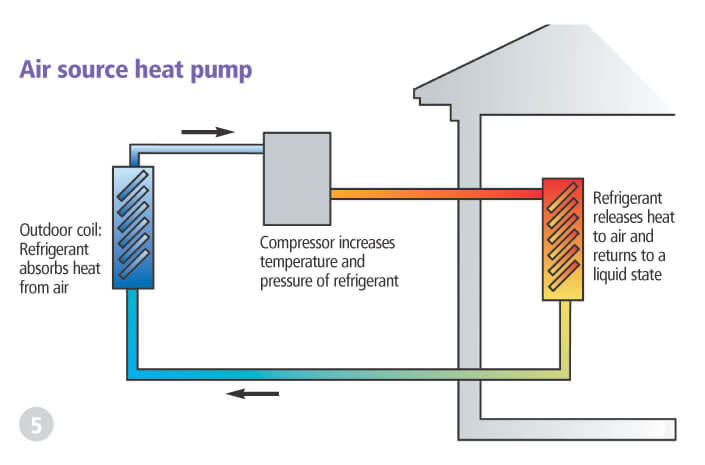Everything you ever wanted to know about heat pumps and more

Bill Kallock of Integral Analytics was interviewed by Catherine Hughes—both are members of the Charlotte Energy Committee. The interview has been lightly edited for length and clarity.
Catherine Hughes: How does your heat pump work?
Bill Kallock: Heat pumps are pretty cool. Even air that is below 32 degrees still has a heat content associated with it, so a heat pump just moves that heat from the outside of the house to the inside of the house—not like a fossil-fuel heating system that burns something to produce heat. This movement of heat is actually what a refrigerator does; it takes the heat inside the refrigerator and moves it outside.
CH: Why is there heat inside a refrigerator?
BK: It’s from food and from you opening the door and letting heat in.
CH: The refrigerator just moves heat from inside to outside? The heat pump is like a little refrigerator?
BK: Yup, it’s the same concept. So cold-climate heat pumps are what are being pushed here in Vermont. Heat pumps were big in the 70s because we didn’t have much natural gas, there was a gas shortage and an oil shortage, and people moved to electrification. Heat pumps are three times more efficient than electric resistance baseboards, but back in the 70s when the temperature went below 35 degrees heat pumps would freeze up and kick into backup electric-resistance heat mode. Heat pumps worked really well in mild climates, but in Vermont, where it is below 40 degrees most of the time in the winter, it was the same as electric resistance and was an expensive heat source.
CH: What changed?
BK: In the 90s, Japan did a lot of research and came up with this inverter system that allowed the heat pump to work as a heat pump down to minus 16 degrees F, so it doesn’t go into electric-resistance mode. This makes cold climate heat pumps much more efficient and cheaper than the 70s versions that some folks may recall. We put a lot of faith in this new technology when we put our heat pump in. We have one heat pump for the whole house, and it is our only source of heat. The compressor outside the house captures the ambient heat in the heat transfer fluid. This fluid is pumped inside and runs through the coils in the air handling unit. The fan in the air handling unit pulls the room-temperature air in from the top, passes the air over the hot coils and warm air comes out the bottom.
CH: Enough to heat your whole house?
BK: Yes. Our house is about 2,000 square feet.
CH: Different than a ground-source heat pump?
BK: Yes. It’s the same concept as a ground-source heat pump, which has pipes that go into the ground—and the ground is always about 50 degrees, so it’s a constant temperature, a constant heat source that could be tapped into to bring heat into the house.
CH: Don’t you have to build new to do that?
BK: No, you can retrofit—you have to have land, to put the tubes in and drill a well.
CH: Expensive?
BK: That’s the rub. The ground-source heat pump is like $30,000 to $40,000. If you have an existing well you can use, you can reduce the cost by a lot, and there are other things that can make it more cost effective. However, a single air-source heat pump is just $4,000.
CH: Is one more efficient than the other?
BK: Both have similar efficiencies. The ground-source heat pump is more efficient because the heat source is more or less at a constant temperature compared to the outside air.
CH: Ground source or air source?
BK: They both work the same way. Since the heat transfer fluid is hotter with a ground-source heat pump, these units have been able to take part of the heat exchange fluid and put it through a heat exchanger in a hot water tank and make hot water. So you are able to get both hot water and space heating from a ground-source heat pump. Mitsubishi has now come out with a cold-climate air heat source pump that has the same idea.
CH: So that’s the change? The indoor hot water?
BK: Yup. Now with one combination unit you can take outside air and produce both space heat and hot water. Stand-alone heat pump hot water heaters use indoor air to heat your hot water so you end up cooling down your house. So the future is looking bright. We’ve got great air-source heat pumps today, but in the future we’re going to have these air-source heat pumps combined with hot water so you’re going to be able to get both.
In building our house we did all the efficiency that we could possibly do first, then added a small heat pump. In our 2,000 square foot house, we use about 9,000 kWh of electricity a year. The heat pump consumes about 3,000 kWh of that, which costs us about $400 annually. It is important to tighten up your home as much as possible. Incidentally, the Charlotte Energy Committee has provided the Food Shelf at the Congregational Church with weatherization tools like caulk and foam for local residents to use on their own homes.

